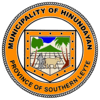Hinundayan, Southern Leyte
| Hinundayan | ||
|---|---|---|
| Municipality | ||
| Municipality of Hinundayan | ||
| ||
| Motto(s): "Hinundayan can do!" | ||
 Map of Southern Leyte with Hinundayan highlighted | ||
.svg.png) Hinundayan Location within the Philippines | ||
| Coordinates: 10°21′N 125°15′E / 10.35°N 125.25°ECoordinates: 10°21′N 125°15′E / 10.35°N 125.25°E | ||
| Country |
| |
| Region | Eastern Visayas (Region VIII) | |
| Province | Southern Leyte | |
| District | Lone District | |
| Barangays | 17 (see Barangays) | |
| Government [1] | ||
| • Type | Sangguniang Bayan | |
| • Mayor | Alfredo Maamo Lagumbay | |
| • Vice Mayor | Elisa dela Cruz-Cadingan | |
| • Electorate | 8,437 voters (2016) | |
| Area [2] | ||
| • Total | 59.90 km2 (23.13 sq mi) | |
| Population (2015 census)[3] | ||
| • Total | 12,285 | |
| • Density | 210/km2 (530/sq mi) | |
| Time zone | UTC+8 (PST) | |
| ZIP code | 6609 | |
| PSGC | 086404000 | |
| IDD : area code | +63 (0)53 | |
| Climate type | Tropical rainforest climate | |
| Income class | 5th municipal income class | |
| Revenue (₱) | 54,414,214.81 (2016) | |
| Native languages |
Boholano dialect Cebuano Tagalog | |
| Website |
www | |
Hinundayan, officially the Municipality of Hinundayan, is a 5th class municipality in the province of Southern Leyte, Philippines. According to the Hinundayan has a total land area of 6,108 hectares or 61.08 square kilometers, comprising 17 barangays. 2015 census, it has a population of 12,285 people.[3]
Historical Background
During the 17th century, there were Spanish sailors who by chance arrived at our shores in Barangay Sabang. At that time, the fisherfolks and villagers were very busy setting up "handayanans" or resting place for their outrigger canoes. These handayanans were made up of posts with horizontal rails which were a meter high from the ground where the canoes and other sea crafts were laid after use. When the Spanish sailors asked the villagers what was the name of the place, the villagers who were oblivious of the strange language thought that they were asked of what they were doing, so they simply answered in their own dialect, "handayanan among gibuhat para sa among baruto." The Spaniards noted the first word "Handayanan" as the name of the place, so they refer the place as such, which was later on distorted to "Hinundayan". Since then, this place was called Hinundayan.
Creation of the Municipality
Before Hinunangan became a town, this and Hinundayan were part of the town of Abuyog. But when it was created a town on the 18th century, Hinundayan was part of its jurisdiction.
On March 21, 1876 the Governor of Leyte Jose Fernandez issued an Executive Order proclaiming Hinundayan a separate town, the first “Kapitan Municipal” was Don Regino Reuterez. But its townhood lasted only until the Revolutionary Period. When the American came, it became a barrio of Hinunangan again. The “Kapitan Municipal” at that time was Don Luis Lagumbay.
Due to the petition of some concerned Hinundayanons, Executive Order No. 59 was issued on July 31, 1909 signed by Governor General William Cameron Forbes and Act No. 986 proclaiming Hinundayan a separate town from Hinunangan.
Barangays
Hinundayan is politically subdivided into 17 barangays.
Demographics
Among the seventeen (17) barangays of the municipality, four (4) barangays are considered urban and the remaining thirteen (13) barangays are rural. Based on the Philippine Statistics Authority (NSO), 2007 Census of Population, the municipality’s population is dispersed in the rural barangays with a total population count of 7,692 or 66% of the total population while the remaining 34% or the 3,918 population count is concentrated in the urban barangays.
| Population census of Hinundayan | ||
|---|---|---|
| Year | Pop. | ±% p.a. |
| 1903 | 5,547 | — |
| 1918 | 8,999 | +3.28% |
| 1939 | 6,830 | −1.30% |
| 1948 | 7,199 | +0.59% |
| 1960 | 7,088 | −0.13% |
| 1970 | 8,546 | +1.89% |
| 1975 | 9,225 | +1.55% |
| 1980 | 9,746 | +1.10% |
| 1990 | 9,965 | +0.22% |
| 1995 | 10,617 | +1.19% |
| 2000 | 11,113 | +0.98% |
| 2007 | 11,610 | +0.61% |
| 2010 | 11,890 | +0.87% |
| 2015 | 12,285 | +0.62% |
| Source: Philippine Statistics Authority [3][4][5][6] | ||
References
- ↑ "Municipality". Quezon City, Philippines: Department of the Interior and Local Government. Retrieved 31 May 2013.
- ↑ "Province: Southern Leyte". PSGC Interactive. Quezon City, Philippines: Philippine Statistics Authority. Retrieved 12 November 2016.
- 1 2 3 Census of Population (2015). "Region VIII (Eastern Visayas)". Total Population by Province, City, Municipality and Barangay. PSA. Retrieved 20 June 2016.
- ↑ Census of Population and Housing (2010). "Region VIII (Eastern Visayas)". Total Population by Province, City, Municipality and Barangay. NSO. Retrieved 29 June 2016.
- ↑ Censuses of Population (1903–2007). "Region VIII (Eastern Visayas)". Table 1. Population Enumerated in Various Censuses by Province/Highly Urbanized City: 1903 to 2007. NSO.
- ↑ "Province of Southern Leyte". Municipality Population Data. Local Water Utilities Administration Research Division. Retrieved 17 December 2016.
External links
- Unofficial Website of Hinundayan
- Official Website of Hinundayan
- Philippine Standard Geographic Code
- Philippine Census Information
- Local Governance Performance Management System
